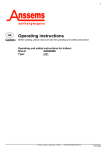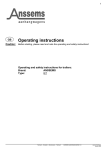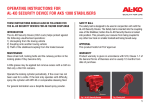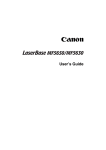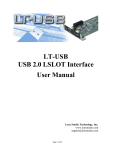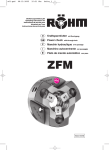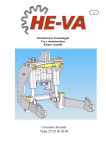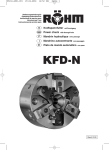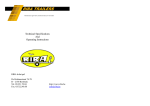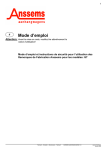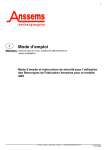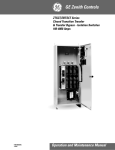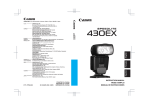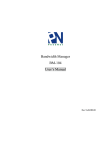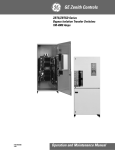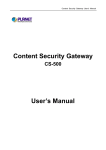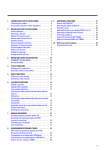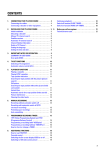Download Operating Instructions
Transcript
GB Operating Instructions Caution: Before starting, please read and note the operating and safety instructions Operating and safety instructions for trailers: Brand: ANSSEMS Types: BSX, PSX, MSX and KSX Table of contents Pagina: 1 Introduction ......................................................................................................................................................................... 2 2 Safety Precautions, Operation, Servecing and Cleaning (general) .................................................................................. 3 2.1 2.2 2.3 2.4 2.5 2.6 2.7 2.8 2.9 2.10 2.11 Trailer (generel) ........................................................................................................................................ Coupling Head.......................................................................................................................................... Overrun Assembly (braked trailer) ............................................................................................................ Axle(s) ...................................................................................................................................................... Electrical connection of the lighting system............................................................................................... Wheel and tyre ......................................................................................................................................... Jockey wheel ............................................................................................................................................ Wheel stops.............................................................................................................................................. Opening/closing of the side boards ........................................................................................................... Pull out beams.......................................................................................................................................... Charging of the trailer ............................................................................................................................... 3 Spare parts........................................................................................................................................................................... 4 Type specific........................................................................................................................................................................ 4.1 4.1.1 4.1.2 4.1.3 4.1.4 BSX, the trailer for general use.............................................................................................................. High cover ................................................................................................................................................ Flatcover................................................................................................................................................... Axle shock absorber ................................................................................................................................. Front-side protection................................................................................................................................. 4.2 4.2.1. 4.2.2 4.2.3 4.2.4 PSX, the platform trailer ......................................................................................................................... Ladder rack .............................................................................................................................................. High cover ................................................................................................................................................ Flatcover................................................................................................................................................... Axle shock absorber ................................................................................................................................. 4.3 4.3.1 4.3.2 4.3.3 4.3.4 4.3.5 MSX, the multipupose trailer.................................................................................................................. Winch ....................................................................................................................................................... Ramps...................................................................................................................................................... Extension sides ........................................................................................................................................ Axle shock absorber ................................................................................................................................. Wheel stop ............................................................................................................................................... 4.4 4.4.1 4.4.2 4.4.3 4.4.4 4.4.5 4.4.6 4.4.7 KSX, the three-way tipper trailer............................................................................................................ General..................................................................................................................................................... Axle shock absorber ................................................................................................................................. Ladder rack .............................................................................................................................................. Extension sides ........................................................................................................................................ Ramps...................................................................................................................................................... High cover ................................................................................................................................................ Flatcover................................................................................................................................................... 4 5 7 8 9 10 11 12 13 14 15 16 17 18 19 20 22 23 25 26 1 Introduction Dear customer, We congratulate you on purchasing a trailer with the brand Anssems. However, in the interests of safety, before using your trailer it is most important that you familairize yourself with the operation of the trailer. If there are any questions about the operation instructions please contact your dealer. Also for servecing and selling from accessories please contact your dealer. Please note It is possible that the pictures in this operation instructions are not the same than the delivered trailer. When we are talking about left, right, for and behind, we mean that you are standing behind the trailer. Anssems Aanhangwagens BV www.anssems.eu Versie: R1 2 2 Safety Precautions, Operation, Servicing and Cleaning (general) 2.1 Trailer (general) • • • • • • No welding is permitted on the hot galvalised parts. Other materials (like aluminium and cables) could be infuence, hereby there is a change on lasting damaging or remodelling. There is a permit allowing the trailer to be used on roads in your country. This means that the vehicle has been formally offered to the inspection authority in your country for approval when your trailer was manufactured in our factory. No modifications of any kind (for example different lighting, wheel rims/tyres or coupling or the addition of an accessory not provided when the vehicle leaves our factory, and due to which the mass and dimensions may change), may be made. Maintenance and cleaning of hot-dip galvanised parts of the vehicle: The formation of white rust is only a cosmetic fault. The following measures may be taken to avoid this to the extent possible: • Ensure that there is sufficient air circulation when parking and in connection with the storage of hot-dip galvanised components. • After driving in winter, the hot-dip galvanised surfaces may be cleaned with clean water in connection with salt/brine (for example using steam jets). For the safety instructions, operation, maintenance and cleaning of trailer component, please refer to items further discussed below, which apply to your trailer. Check whether driving with the trailer is officially allowed. Can the towing vehicle drive with the trailer, and does your driving licence permit you to drive the combination? Ensure conformity with the applicable laws relating to what the load may or may not consist of (such as hazardous substances and passengers). 2.2 Couplung Head Safety Precautions: • Always ensure that the coupling head is properly connected to the towing vehiclis towball every time you couple up. If not coupled up correctly the trailer may become detachted from the towing vehicle and cause an accident! • Maximum possible articulation of the coupling head must not exceed +/- 25° vertically and +/- 20° horizontally. If exceeded, components will be overloaded and the operation of the assembly adversely affected. Operation: Operation of couplings of the brand AL-KO and type AK7 on unbraked trailers and AK75 / AK160 / AK300 / AK 350 on braked trailers: • Articulation: Maintain articulation angle at +/- 25° (vertically Fig. 1) Maintain articulation angle at +/-20° horizontally (Fig. 1) Caution: If the articulation angle is exceed, components will be overloaded. The function si no longer ensured! • Coupling Up ( AK 7): Push the safety lever (afb. 4/1) up with the index finger and lift the handle up and forwards. Put the openen coupling onto the towball with the handle pulled up and in addition press down by hand. The coupling will close by applying a light pressure. Press the handle down by hand untill the catch (Fig. 4/3) snaps out. The coupling head is correctly engaged when the green edge of the visual indicator is visible (Fig. 4/2) Caution: It is most important to check that the coupling head is properly engaged on the towball each time. • Coupling Up (AK75 / AK160 / AK 300 / AK 350): Open coupling head. To do this pull the coupling handle up (Fig. 2/1) in the direction of the arrow. The coupling mechanism had fixed open position, i.e. as long ad the coupling head is not placed on the ball the coupling handle will remain open. Put the open coupling on the ball of the towing vehicle. The nose load on the coupling head automatically and audibly clics into position. In the interests of safety press the handle down by hand as well (Fig. 2/1). Locking and securing takes place automatically. The coupling ball is correctly connected when the green cylinder of the safety indicator is visible when the trailer coupling is viewed from the side (Fig. 2/2). The coupling mechanism is correctly engaged when the coupling handle can no longer be pressed down by hand. Caution: When the coupling head is not correctly hitched onto the towball then the trailer can become disconnected from the towing vehicle. • Uncoupling: Lift coupling handle fully and remove the coupling head from the towball of the towing vehicle. Where there are higher nose loads, coupling and uncoupling can be made easier bu use of the jockey wheel. • Wear indicator (AK 7): If the handle reaches back to the cutaway portion of the housing when the coupling head is engaged (Fig. 5) there wil be play between the towball and the coupling head! Automatic readjustment is no longer possible and the assembly will require inspection. Caution: Under these circumstances the coupling head can become detached from the coupling ball and the trailer break away from the towing vehicle. The coupling head and towball must therefore be checked immediately before future use. Any faulty patrs must be charnged immediately. All mainenace work is to be carried out by specialist workshops. Wear indicator (AK75 / AK160 / AK 300 / AK 350): A wear indicator on the coupling head (Fig. 3) shows whether the wear limit of the towing vehicle’s towball or the trailing coupling has been reached or not. For this purpose hitch up the trailer to the towing vehicle (see Coupling Up) and drive the car and trailer approx. 500m. This will set the coupling head adjustment. Following this check wear as follows: If the green indicator is visible on the coupling head with the coupling engaged (see Fig. 3/2) the coupling head is in a new condition or the wear on the towball is within permissible limits. When the green indicator on the coupling handle is completely covered over and only the red indicator visible (Fig. 3/1) this could be caused by the following: • The towball has reached the lowest wear limit of dia. 49 • Both coupling head and the towball are showing sings of wear • Towball is in a new condition with dia. 50 but the coupling head is showing an excessive level of wear Caution: Under these cicumstances the coupling head can become detached from the coupling ball and the trailer break away from the towing vehicle! The coupling head and towball must therefore be checked immediately befor future use. Any fauly parts must be changed immediately. All maintenace word must be carried out by specialist workshops. Anssems Aanhangwagens BV www.anssems.eu Versie: R1 3 Servicing and Cleaning: Lubricationg points (Fig. 6) Clean towball coupling. Lightly grease, or oil ball socket, jonts and bearing points as appropriate. General purpose grease to DIN 51825 KTA 3K. Troubleshooting Fault Cause Coupling does not engage when placed on ball. Ball diameter grater than 50 mm. Inner parts of the coupling are dirty or are not funtioning correctly. Trailer cannot be uncoupled Ball deformed. Too much play in the coupling danger of the trailer becomming unhitched. Coupling worn out. Articulation angle exceeded. Rivet bent. 1 2 4 5 Elimination Change ball Clean and grease coupling, replace as neccesarry. Align trailer and car and uncouple. Grease/lubricate coupling mechanism. Have coupling changed. Have towball changed. 3 6 2.3 Overrun Assembly (braked trailer) Safety Precautions: • When parking your vehicule and trailer on site you must applly the trailer parking brake. If the trailer is parked and then diconnected from the towing vehicle it is recommended that each wheel is chocked using suitable wheel chocks. Caution: Please note when parking the trailer that the wheelbrake auto-reverse mechanism will allow the trailer to travel backwards for approximately 25 cm. (Please allow sufficient clearance when parking.) Operation: AL-KO overrun devices are of the mechanical overrun type using and hydraulic damper. • Coupling Up Manoeuvre towing vehicle or trailer to couplingpoint. Fully open coupling head handle and securely hitch onto the towball of the towing vehicle. -> See operating instructions for 50 mm coupling head. Thread the breakaway cable through the breakaway cable guide provided (Fig. 2) and connect it to attachment point provided on towing brecket (Fig. 1). Only for Scandinavian countries (see fig 1a). The breakaway cable operates the hand-brake (emergency brake) in the event of the trailer becoming detached from the towing vehicle during towing. For this emergency brake to work correctly it is absolutely necessary that the breakaway cable runs through the breakaway cable guide and is not resticted in any way Caution: The Brake-away cable must be of sufficient length to avoid applying the emergency brake in advertently when conering. Overrun device fitted with 50 mm coupling head/ eye end Connect trailer electric plug controlling lights & indicators etc. to towing vehicle socket. Wind the jockey wheel up fully clamp securely in position ensuring that it does not foul brake rod or breakaway cable. (See operating instructions for jockey wheel.) Ensure handbrake is in the fully of position by pushing it right down. (See Figures 3-6) Caution Failure to comply with this could result in the brakes overheating! For details on the hand-brake see section on Uncoupling. Remove wheel shocks and store or stow safely. Uncoupling Secure trailer by chocking both wheels. Apply hand-brake fully. There are 4 different hand-brake systems. With all four systems please observe the following: Hand-Brake lever with gas strut (Fig 3) Enure handbrake is fully applied (as highlighted). This will ensure that the gas strut will automatically reapply the wheel brakes if trailer starts to roll backwards. To release: Press the hand-brake push button fully home and firmly press the handbrake lever back into the off position (handbrake horizontal) Servicing: Every 10 000 – 15 000 km or every 12 months: Anssems Aanhangwagens BV www.anssems.eu Versie: R1 4 Lubricate/grease all sliding and moving parts of the overrun device as shown in Fig. 7. Recommended lubricant: General purpose grease to DIN 51825 KTA 3KA Troubleshooting Fault Cause Elimination Poor Breking Overrun shaft/linkages tight Overrun shaft corroded Damage to body housing Hand-brake not fully released Wheel fouls brake rod Gas strut defective Axle shock absorbers defective Release hand-brake Check transmission system operates smoothly. Check overrun lever moves freely Slacken locking handle and repossition accembly correctly Replace gas strut Replace schock absorbers Ovverrun damper defective Replace overrun damper Brake overheating during towing Handbrake force low Uncomfortable ride Trailer brakes applied during decleration or downhill travel Grease transmission system and all moving parts 2.4 Axle Safety Precautions: • No welding is permitted on AL-KO axles. • It is most important that the wheel and hub/brake drum are dimensionally compatible. This means that the P.C.D., wheel bolts and inset must all be compatible with both the hub/brake drum and the wheel rim. Particular attention must be paid to the recommended torque figures for the wheels bolts. Operation Instructions: Function: Service brake: When the towing vehicle is braking or travelling down hill the overrun device shaft is pushed in (dependent on the magnitude of the thrust on the shaft) and presses on the overrun lever. This acts on the bowden cables an expander mechanism which in turn expands the brake shoes applying the wheel brakes. Reversing: When the towing vehicle is reversing, the overrun device shaft is pushed in, applying the brakes via the overrun lever, brake rod system, bowden cables and the expander mechanism. The backwards rotation of the brake drum causes the secondary brake shoe to collapse cancelling out the braking effect allowing the trailer to move backwards. At the same time the transmission lever swings back and compensates for the entire travel Parking Brake: With the gas strut version pull the hand-brake lever over top dead centre. With the spring cylinder version pull the hand-brake lever right up to the last tooth. The trailer is then braked. Important note: Please note that with the handbrake fully applied the trailer is able to move backwards by 25cms until the spring cylinder/gas spring takes effect. Anssems Aanhangwagens BV www.anssems.eu Versie: R1 5 Maintenance and cleaning: Braked axle: The axels comes fitted with maintenance tree wheel bearings (greased and seled for life) and no adjustment is necessary. The hub bearing is not protected against water ingress. Check wheel brake linings for wear every 10 000 kilometres or every 12 months via the inspection hole (Fig.2/1) Adjust if necessary. Where continuous travel in hilly regions or high mileage is experienced earlier inspection and adjustment may be necessary. Unbraked axle: After 1500 km or 6 months; Have the axial play of the hub bearing checked an adjusted, if necessary. Caution: All necessary service work should only be carried out by trained personnel in specialist workshops. Troubleshooting Fault Cause Poor braking Linings are not fully bedded in. Linings are damaged/dirty Friction losses too high, overrun device shaft corroded. Reversing heavy or blocked Only occurs when the braking system is set too thightly. Auto-reverse lever is stuck. Brakes overheating when driving Incorrect setting. Braking system not fully released during forward travel. Overrun lever stuck Wheel brake dirty. Cable or Bowden cable kinked. Release springs defective or broken. Rust deposit in brake drum(s) Handbrake force low Incorrect setting – friction losses too great. Linings are not run in. Friction losses too high. Uncomfortable ride or jerky braking Too much play in the braiking system. Shock absorber defective. Anssems Aanhangwagens BV www.anssems.eu Versie: R1 Elimination Will pass after braking a few times. Have set replaced. Ensure smooth action of transmossion Equipment including brake cable. Re-adjust braking system. Restore to working order and lubricate. Check brake adjustment. Release hand-brake. Check transmission equipment (ensure smooth action). Check overrun lever. Clean. Renew Bowden cable. Renew springs. Replace brake drum(s) and shoes, if necessary. Check stting. Will pass after braking a few times. Ensure smooth action of transmission equipment including Bowden cable. (Oil) Check setting. Have shock absorber checked and if necessary change. 6 2.5 Electrical connection of the lighting system • • • • • • • • • When coupling the trailer, the proper working of the lighting system should be checked after inserting the plug into the vehicle plug. If the working is not satisfactory, the cause of the problem should first be identified and repaired before the combination is driven on public roads. Your trailer is equipped with a 7-pole plug as per ISO 1724. If the towing vehicle is not equipped with a plug socket of this type (but is equipped with a 13-pole plug as per ISO 11446 for example), the lighting will not work properly. This can be remedied by using an adapter for connecting a 13-pole vehicle plug socket to a 7-pole trailer plug. These adapters are commercially available. This adapter will be placed between the plug of the towing vehicle and the plug of the trailer. You may check whether the towing vehicle is equipped with the same type (7-pole) of plug in the following manner: • If the words “ISO 1724” appear on the plug, it means it is a 7-pole plug; if the words “ISO 11446“ appear, it means it is a 13-pole plug. • Please enquire with the supplier of the towing vehicle. No extra lighting fixtures need be added. When replacing (incandescent) lamps, it should be ensured that the replacement (incandescent) lamp is in accordance with (12V/5W – 12V/21W). For this, check the information appearing on the replacement (incandescent) lamp. The trailer is permitted for use on the road in your country. This means that the vehicle has been offered for inspection to the authority responsible for the same, as soon as your trailer is manufactured in our factory, and therefore fulfils the applicable permit requirements. No modifications or additions may be made to the same (extra lighting and the addition of for example, "lighting safety grills"). After coupling, the 7-pole plug of the trailer should be immediately inserted in the plug of the towing vehicle. This is only possible in one way. The plug connection is as follows (with, in sequence, the connection number / code, colour of the wiring and function): • 1/L Yellow Left turn indicator • 2 / 54G Blue Fog lamp • 3 / 31 White Earth • 4/R Green Right turn indicator • 5 / 58R Brown Rear lamp, right • 6 / 54 Red Braking light, left and right • 7 / 58L Black Rear lamp, left 2.6 Wheel and tyre • Ensure that the tyres are at the correct tyre pressure and have an adequate tyre tread (as regards safety and uniformity of wear-and-tear). The tyre pressure should be applied in the "cold" condition with the vehicle in an unloaded condition. Tyre Tyre Pressure [bar] 175/70 R13 / 2.5 185/70 R13 185 R14 / 4.5 185/80 R14 195/50 R13 6.5 195/55 R10 6.25 ATTENTION: You cannot ensure that your tyres have a minimum pressure of 6.25 bars in all places. If tyres have a tyre pressure less the values mentioned in the table, there is a chance of punctures. The tyre pressure should be checked regularly. For information about the minimum tyre tread, please abide by the applicable regulations. • The following applies to a new trailer: After 50 km, tension the wheel nuts with a suitable tool. This should be done with a tightening torque of 90-120 Nm. If a trailer is regularly used, it should also be regularly checked later on. Anssems Aanhangwagens BV www.anssems.eu Versie: R1 7 2.7 Jockey wheel • • • • • The jockey wheel is for coupling, uncoupling and shunting of the trailer. Ensure that the maximum permissible coupling pressure is not exceeded through the loading of the trailer. At this load, where the jockey wheel is used, a permissible load of the jockey wheel will arise. Operation of the jockey wheel, Version 1 (unbraked trailer) • Uncoupling of unbraked trailer: • Open the jockey wheel holder by releasing the clamping handle (1), lower the jockey wheel as far as possible and tighten the clamping handle (1) again. • Uncouple the auxiliary coupling and the lighting plug from the towing vehicle. Use the wheel stops for the unbraked trailer. • Open the coupling head, and simultaneously turn out the jockey wheel by turning the handle (2) to the left, until the coupling of the towing hook ball is detached from the towing vehicle. • Coupling of unbraked trailer: • The coupling must be done in reverse order: • Turn up the jockey wheel until the wheel flanges are fixed in the recess of the outer tube (3). The clamping handle (1) Version 1 must be firmly tightened. • The jockey wheel is thereby secure against accidental detachment during motion. • The jockey wheel should be pulled-up to the maximum possible extent using the clamping bracket. While doing this, the wheel should be more or less parallel to the pole. • Tighten the clamping handle (1) until the jockey wheel is secured against being pushed downwards. Operation of the jockey wheel, Version 2 (braked trailer) • Uncoupling the braked trailer: • Disconnect the break-away cable and the lighting plug of the towing vehicle. Pull-up the hand brake of the trailer. • Before the trailer is uncoupled from the towing vehicle, the jockey wheel should be turned out. The first step for unfolding (1) is to turn the handle anti-clockwise. After this, the wedge (2) reaches its end position and the jockey wheel is turned out. • Open the coupling head and turn out the jockey wheel to the desired height, due to which the coupling arises above the towing hook ball. ATTENTION: When the trailer is uncoupled, the jockey wheel will be placed under load (3). For this reason, never turn-in the jockey wheel after uncoupling to such an extent that the folding mechanism is operated! • Coupling of braked trailer: • The coupling must be done in reverse order: • After coupling, the jockey wheel should be again fully turned up. When doing this, ensure that the folding wedge (2) touches the collar (4) of the jockey wheel and when the handle is turned further clockwise, moves over the collar/flange of the jockey wheel. The jockey wheel will then automatically be folded upwards. ATTENTION: The jockey wheel is only fully turned-up when it is fully folded upwards. ATTENTION: When turning-up the jockey wheel, ensure that the brake rod of the trailer does not touch any part of the jockey wheel. If it touches the brake rod, the brake will no longer work optimally. ATTENTION: The following applies to both versions of the jockey wheels: Regular cleaning and lubrication of the moving parts. Version 2 2.8 Wheel stops • • • • • Use the wheel stops to uncouple the trailer. This will prevent the trailer from moving. In the braked version, use the hand brake of the trailer in addition to the wheel stops. Before placing the wheel stops, check the condition of the base surface on which the wheel stop will be placed. This should be sufficiently sturdy. Before uncoupling the trailer, first place the wheel stops (depending on the slope of the base surface) in front or behind the tyres (the right and left tyre). In case of tandem axle versions, select the front or back axle. Before coupling the trailer once again, you should also actually first uncouple and then remove the wheel stops on the tyres and store them away in the holder installed on your trailer for this purpose. 2.9 Opening and closing of the side boards • • • • When opening and closing the side boards, ensure that persons present near the boards are not exposed to danger, or risk getting entrapped, or injured in any other manner whatsoever. While opening the tailboards on public roads, the applicable laws should be duly followed. If the applicable laws require this, use the pull-out beams present in the trailer. When the tailboard is resting on the pull-out beams, the lighting fittings remain visible. ATTENTION: Ensure that you are visible during loading/unloading on public roads. This is for your safety and that of other road users. NEVER ride with the opened sides. Ensure regular lubrication of the lock mechanism. This can be done from the top using a Teflon or silicone spray. 2.10 Pull out beams • The lock for the pull-out beam is placed behind the lighting box. The pull-out beam is unlocked on pulling down the lock, and can be pushed out backwards. The tailboard can thereby be laid horizontally on the pull-out beams. The lighting and reflectors will therefore remain visible during loading and unloading. ATTENTION: During loading and unloading on public roads always place the pull-out beams around the tailboard. Ensure that you are visible during loading/unloading on public roads. This is for your safety and that of other road users. Anssems Aanhangwagens BV www.anssems.eu Versie: R1 8 2.11 Charging of the trailer • • • • • • The cargo should be properly secured in place. This is to prevent loss and shifting of the cargo during motion. The shifting of the cargo may lead to a sudden change in the handling characteristics of the vehicles. Furthermore, while loading the vehicle on public roads, follow all the applicable regulations (among others, the visibility of the lighting and maximum length of projecting cargo). Check whether it is permissible to drive with the trailer. • Does the towing vehicle allow driving with the trailer? • Is the combination in accordance with your Driving Licence? It is preferable to load and unload your trailer in the coupled condition. If this is not done, check whether the trailer may "topple" (the jockey wheel lifts off the ground) during loading or unloading. Follow the applicable laws concerning what the load may consist of (such as hazardous substances and persons). While loading the trailer, keep in mind the net loading capacity of the axle(s) and the coupling. Distribute the loading in such a manner over the loading floor that the correct coupling pressure is achieved. This coupling pressure should never exceed the maximum permissible level, and should also be in accordance with the possible coupling pressure for the towing vehicle. For the correct information, please contact your (towing) vehicle supplier, or check the user manual of the towing vehicle. • ATTENTION: The coupling pressure should never be negative (this would mean that the coupling is pulling vertically on the towing hook ball of the towing vehicle). For the minimum coupling pressure, duly follow the applicable laws and regulations. • ATTENTION: Your trailer is designed, calculated and tested (through a life test) for the loads as mentioned in the documents relating to your trailer, and for the maximum speed applicable on public roads for a towing vehicle with trailer. The permissible loads may be found on the construction plate (or the type plate) installed on the trailer. Overloading may lead to permanent damage to some components. We accept no liability for the same as manufacturers. 3 Spare parts Replacement parts are safety critical parts. Should parts other than original spare parts be used then warranty and product liability becomes void, i.e. we as munufactures will not be liable for any faults that may occur following fitment of non original spares. 4 Type specific 4.1 BSX, the trailer for gerneral use 4.1.1 High cover Anssems Aanhangwagens BV www.anssems.eu Versie: R1 9 The cover will be supplied in the following components: Nr. 1 2 3 4 5 6 7 8 9 10 11 12 Description Alu plank for cover front Cap Roof-beam Cover leg left-front Roof-beam Cover Leg right-front Roof-longitude Alu plank site Tarpaulin + TIR-cable TIR- bracket rivet Φ4,8x10 Cover leg left-back Cover leg right -back The cover frame body is installed as schematically represented in the above-mentioned diagram. Remove the plastic covers of the four corner posts of the trailer, check the corner posts for excess zinc (remove if necessary) and place the frame in these corner posts. Place the tarpaulin over the frame and install the TIR brackets supplied on the aluminium boards using the blind rivets Φ4.8x10. The installation pattern should correspond to that of the tarpaulin. See the detail below Detail: Install the TIR brackets provided on the aluminium boards, using the blind rivets Φ4.8x10. Anssems Aanhangwagens BV www.anssems.eu Versie: R1 10 4.2.3 Flat cover The flat cover will be supplied in the following components. Spare parts: Nr. 1 2 3 Description Flatcover Cover support (2 x alu profile) “TIR”-bracket, hooks, elastics en rivets Φ4,8 (in bag) Push the tarpaulin supports (aluminium u-profile) over the railing with the open side of the profile pointing toward the inside of the trailer. The caps on the trailer do not have to be dismantled for this purpose. Hang the tarpaulin over the plane so formed, and then install the brackets and the hooks provided, using the blind rivets Φ4.8 on the aluminium side board and covers. For this, see the sketch above. The installation pattern should correspond to that of the tarpaulin. ATTENTION: When placing the hooks on the tailboard, check to ensure that the hooks do not touch the lighting and the underside of the lighting box. Anssems Aanhangwagens BV www.anssems.eu Versie: R1 11 4.1.3 Axle shock absorbers The axle shock absorber will be installed in the following manner for the type BSX: Axle shock obsorber (by braked trailers) BSX 2000.251 (mounting plate backwards) Other BSX models (mounting plate forwards) The axle shock absorber will be installed in the following manner for the type BSX: Anssems Aanhangwagens BV www.anssems.eu Versie: R1 12 Components: One installation set for axle shock absorbers contains components for 1 axle: No. 1 2 3 4 5 6 Description M12 nut Axle shock absorber (2 per axle) Mounting plate M12 bolt (short) M12 bolt (long) Mounting clamps Installation sequence: • Remove the plastic cover in the wheel arm • Install the mounting clamps (1xL and 1xR) together with the axle shock absorber using the M12 bolt (long) • Ensure that the axle shock absorber is fully pushed-in • Install the mounting plate on the chassis and tighten it by hand with a bolt (M12 (short)). • Install the axle shock absorber on the mounting plate (M12 (long)) • Now turn the plate so that the mounting plate hole aligns with the hole in the chassis. The axle shock absorber will then assume the correct length. • Install the mounting plate on the chassis with the last bolt (M12 (short)) ATTENTION: Bolt heads should always point in the direction of the tyre and the axle shock absorber will be installed on the "inner side" only for the type BSX. For details, see the next page. After installation, check that the tyres have sufficient play (min. 16 mm). 4.1.4 Front-side Protection Protection on the front-side This protection will be provided to you through the components as per the accompanying diagram: For each side: 1 x the safety profile 2 x spacer bushings 2 x hexagonal bolts 2 x self-locking hexagonal nut The chassis beam contains the holes for the fixing of the safety covers. Sequence of actions: Place the spacer bushings in the profiles and insert the hexagonal bolt into the holes of the safety profile and the spacer bushings from below. The nut will then be on the inner side of the chassis beam. Tighten the bolt connection. Anssems Aanhangwagens BV www.anssems.eu Versie: R1 13 4.2 PSX, the platform trailer 4.2.1 Ladder rack The ladder rack will be supplied in the following components: Spare parts: Nr. 1 2 3 4 5 Description Cap Tightener for ladder rack Ladder rack Plate M12 nut In case of No. 1 : The plastic cover is generally installed on the trailer corner post. Remove this before installing the ladder rack. Installation sequence: • Remove the plastic covers of the corner posts • Place the ladder racks in the corner posts • Place the clamping bolt in the column of the ladder rack. ATTENTION: See image for details of the method to be used. • Place the clamping plate under the corner post. ATTENTION: See image for details of the method to be used. • Screw the nut on the clamping bolt and tighten the same. • Place the plastic covers of the corner posts on the columns of the ladder rack 4.2.2 High cover The high cover will be supplied in the following components: Spare parts: Nr. 1 2 3 4 5 6 7 8 9 10 Anssems Aanhangwagens BV www.anssems.eu Versie: R1 Description Alu plank front Cap Cover leg left-front en right-back Roof-beam Cover leg right –front en left-back Roof-longitude Alu plank site Tarpaulin + TIR-cable TIR-hook Rivet Φ4,8x10 14 Description of assembly: The cover frame body is installed as schematically represented in the previous page. Remove the plastic covers of the four corner posts of the trailer, check the corner posts for excess zinc (remove if necessary) and place the frame in these corner posts. Hang the tarpaulin over the frame and install the TIR brackets supplied on the aluminium boards using the blind rivets Φ4.8x10. The installation pattern should correspond to that of the tarpaulin. For this, see the details for installing the cover frame on the BSX type trailer. 4.2.3 Flat cover The flatcover will be supplied in following components: Spare parts: Nr. 1 2 3 description Cover + “TIR”-cable “TIR”-hook Rivet Φ4,8x10 Description of assembly: Hang the tarpaulin over the boards and install the TIR brackets supplied on the aluminium boards using the blind rivets Φ4.8x10. The installation pattern should correspond to that of the tarpaulin and also for example, the pattern of a cover frame. See image for details of how to install a flat tarpaulin cover on the BSX trailer. 4.2.4 Axle shock absorber Axle shock absorber Anssems Aanhangwagens BV www.anssems.eu Versie: R1 15 The axle shock absorber will be installed in the following manner for the type PSX: Spare parts: One installation set for axle shock absorbers contains components for 1 axle: No. 1 2 3 4 5 6 Description M12 Nut Axle shock absorber Mountig plate M12 bolt (short) M12 bolt (long) Mounting clamps Installation sequence: • Remove the plastic cover in the wheel arm • Install the mounting clamps (1xL and 1xR) together with the axle shock absorber using the M12 bolt (long) • Ensure that the axle shock absorber is fully pushed-in • Install the mounting plate on the chassis and tighten it by hand with a bolt (M12 (short)). • Install the axle shock absorber on the mounting plate (M12 (long)) • Now turn the plate so that the mounting plate hole aligns with the hole in the chassis. The axle shock absorber will then assume the correct length. • Install the mounting plate on the chassis with the last bolt (M12 (short)) ATTENTION: Bolt heads should always point in the direction of the tyre and the axle shock absorber will be installed on the "inner side" only for the type BSX. After installation, check that the tyres have sufficient play (min. 16 mm). 4.3 MSX The multipurpose trailer 4.3.1 Winch The winch is installed on an adjustable console. This console is to be placed at two different locations in the breadth direction in the front cross bar and in three different positions in the longitudinal direction. Scope of application The winch is suitable for use as a trailer winch for the easy and shock-proof pulling of various loads. The maximum tractive force of the winch in the lowest cable layer is 330 kg and 900 kg in the topmost cable layer. Only cables according to the regulations should be used. Anssems Aanhangwagens BV www.anssems.eu Versie: R1 16 Safety Information Friction disk brake: Minimum tractive force for perfect brake function: 25daN. If this minimum load does not exist the braking function does not take place! Not approved for motor-driven operation! Only touch the wire cables when wearing protective gloves! The rope (belt) must only be wound up so far under load that a flanged wheel overhang of at least 1.5 x cable diameter is guarateed! The cable must be wound round the drum an least twice under load! Derermine the fitting position so that when the winch is used the fleet angle is no more than 4˚. Do not oil of grease the brake mechanism! The cable winch must not be used for securing loads! (e.g. cars) Here the load requires separate lashing as the cable winch friction disk brake can be loosened by vibration during the journey. Operation Lifting, pulling: Turn the head crank clockwise. Stopping: The load can be stopped in any position by simply letting go of the crank. Lowering: Turn the cank anti-clockwise to lower the load. The automatic brake prevents the crand from kicking back (load pressure brake) warning: The rope (belt) must only be wound up so far under load that a flanged wheel overhang of at least 1,5 x cable diameter is guarateed. This prevents the winch from overload and stops the cable from running from the dum sideways. The cable must be wound rouend the drum at least twice under load. Friction disk brake: Minimum trative force for perfect brake function: 25daN. If this load does not exist the braking function does not take place! The cable (under load) must be kept under slight tension for correct winding. Maintenenance and cleaning Check the wire cables regularly for wear. Removal criteria as per DIN 15020: E.g. crushing, breakes in the individual wires. Should these cables be damaged, they must be replaced immediately. The winch has already been lubricated in the works. It is recommended however that the drive shaft bearing bushes and the drum hub be olied regularly. Grease the toothed wheel rim regularly. Ensure that the crank gear is always lubricated Warning: Do NOT oil or grease the brake mechanism! A competent person must inspect the cable winch at least once a year in accordance with the operating conditions and the situation in wich it is used. This inspection is required in accordance with the German Accident Prevention Regulations for winches, Lifting and Pulling Machinery (VGB 8 23) 4.3.2 Ramps The original ramps supplied and the ramp support on the trailer have been developed and tested for a maximum axle load of 1250 kg. For each ramp, the wheel load is max. 625 kg . The ramps are intended to carry a load of rotating wheels (like vehicles) for loading or unloading cargo on/off the MSX multi-transporter. Attention: Never handle the ramps without protective gloves. The ramps should not be used as a gang plank since they have a grip profile. There is a danger of falling due to the variation in the surface. The ramps are stored in the chassis of the trailer. They can be accessed after opening the flaps on the rear of the trailer. The operation of the lock is similar to that for opening and closing the zip fasteners described in the section "Winches". Take care that the ramp does not fall out of the storage location as you push it out with safety gloves. Please exercise all necessary caution. Anssems Aanhangwagens BV www.anssems.eu Versie: R1 17 Replace the ramps in the appropriate manner after use. Check the following: whether the ramps are at right angles with respect to the rear of the trailer. If not, the proper placement cannot be guaranteed. Check whether the ramp is fully on the front tip. If not, the ramp may be lifted out of its location when vehicles drive up the ramp. This will lead to a hazardous situation. Check whether the hook is touching the vertical edge on the back of the trailer. Dirt in the channel may lead to an incorrect ramp placement. check whether the ramps are at the correct distance from each other. Keep in mind the distance between the insides of the wheel rims of the vehicle being driven up. check whether the maximum permissible load is being exceeded. check whether there is visible damage on the ramps check that there are no persons in the vicinity of the vehicle being driven up or down. This would be hazardous. Such persons may be injured in case of an unexpected situation that may arise if a vehicle does not drive up or down properly. check whether the ramps are free of dirt, ice and snow. check whether you are conforming to the applicable laws and regulations when on public roads. If the lighting fittings are no longer visible, you should take appropriate measures (for example, use the warning triangle). ATTENTION: Ensure that you are visible during loading/unloading on public roads. This is for your safety and that of other road users. The ramps should be checked at least once a year by duly trained personnel in authorised workshops or service centres. 4.3.3 Extension sides The entire original set consists of four corner corner posts (including fastening material), two side boards, one front and one rear board. Description of assembly: 1. 2. 3. 4. 5. 6. 7. 8. 9. Remove the plastic covers of the corner post bases from the trailer Remove the brackets from the four corner post bases. Drill a hole of ø9 mm in the corner post bases on the trailer (if this is not already provided by the factory). This hole must be drilled on the side board of the corner post base and at 5 cm from the top side. The wire block on the inner side of the corner post base should be held in front of the hole with a finger. Turn the M8 bolt in the wire block. A few turns of the thread will be sufficient. Place the corner post in the corner post base. Tighten the M8 bolt. The plastic covers that have been removed from the corner post bases may be placed on the corner posts. Put the locks of the board to be installed, in the position "Open", and place the same on the edge or in the opening (on the rear) of the trailer. "Close" the lock. Each week, check whether the M8 bolt is still properly in place (fixing of the corner post). ATTENTION: If the corner post is not fixed in place, it means that the boards are not properly secured. There is a danger that they may come off. When installing and dismantling (removing) the extension boards, ensure that persons present near the boards are not exposed to danger, or risk getting entrapped, or injured in any other manner whatsoever. While dismantling the extension boards on public roads, the applicable laws should be duly followed. If the rear board is removed, it should be stored in such a manner that the lighting fittings are visible. ATTENTION: Ensure that you are visible during loading/unloading on public roads. This is for your safety and that of other road users. Ensure regular lubrication of the lock mechanism. This can be done from the top using a Teflon or silicone spray. Anssems Aanhangwagens BV www.anssems.eu Versie: R1 18 4.3.4 Axle shock absorbers The axle shock absorber will be installed in the following manner for the type MSX: : Components: One installation set for axle shock absorbers contains components for 1 axle: No. Description 1 M12 Nut 2 Axle shock absorbers 3 Mounting plate 4 M12 Bolt (short) 5 M12 Bolt (long) Mounting clamps 6 Installation sequence: • Remove the plastic cover in the wheel arm • Install the mounting clamps (1xL and 1xR) together with the axle shock absorber using the M12 bolt (long) • Ensure that the axle shock absorber is fully pushed-in • Install the mounting plate on the chassis with a bolt (M12 (short)) (and tighten it by hand). • Install the axle shock absorber on the mounting plate (M12 (long)) • Now turn the plate so that the mounting plate hole aligns with the hole in the chassis. The axle shock absorber will then assume the correct length. • Install the mounting plate on the chassis with the last bolt (M12 (short)) ATTENTION: Bolt heads should always point in the direction of the tyre and the axle shock absorber will be installed on the "inner side" only for the type BSX. For details, see the following pages. After installation, check that the tyres have sufficient play (min. 16 mm). 4.3.5 Wheel stop The wheel stop may be used to fix a vehicle in position. The use of the wheel stop does not require any modifications to the trailer. If a particular type of vehicle is transported more often, one may determine the proper place for the vehicle in order to obtain an optimum coupling pressure. Attention: In addition to placing wheel stops (or a set of two units), secure the vehicle being transported in place with a little extra firmness. Place the wheel stop originally supplied with its lock secured on one side in a hole in the side of the MSX multi-transporter. Then push in the other lock and place the wheel stop flat on the floor with the locking pin in front of a hole. Release the lock and check whether the lock is fully out. Attention: The wheel stop should never be held without protective gloves. Anssems Aanhangwagens BV www.anssems.eu Versie: R1 19 4.4 KSX the three-way tipper trailer 4.4.1 General The KSX tipper is available in versions with hand pump or electrical pump. KSX tipper with hand pump KSX tipper with electrical pump It is possible to tip from the rear as well as sideways. The KSX is therefore provided with hinges at every corner point. Two locking pins have been provided for these hinges. Decide the location of the pins according to the side on which tipping will take place. There are three possibilities: Top view Front view Tipping right Tipping left Tipping rear ATTENTION: Placing the pins "diagonally" (for example, left-front and right-rear), will cause damage. The pin must be placed in the hole of the recess (part of the hinge on the lifting platform) and under the ball (part of the hinge on the bottom frame). To insert it fully, turn it a quarter turn. If the small pin placed transversely on this pin is behind the locking edge, the second lock, namely the hairpin spring, must be installed through the hole in the pin. The pin will now be prevented from turning in the hinge hole. Attention: A tipper is also used for transporting and tipping sand. If the full container (3.05m x 1.78m x 0.3m) is filled with sand (about 1750 kg/m3), the load is about 2,800 kg . You will therefore be able to monitor the total weight (empty mass + cargo) of your trailer!! If tipping function is used, the following general aspects should be checked before tipping (specific actions for the tipper for each version have been given below): the trailer should be correctly coupled to the towing vehicle (which is on hand brake or in gear) the wheels of the trailer are placed on a stable base surface, the locking pins are correctly placed in the hinges the board in question is open, no persons should be present near the vehicle, When you are on the open road: ATTENTION: Ensure that you are visible during the tipping operation on public roads. This is for your safety and that of other road users. During rear tipping, for example, the oncoming traffic from the rear cannot see the lighting and the reflectors during the unloading. Maintenance Weekly inspection: • check the hinges (ball and recess) for dirt and clean the same if necessary. • the hinge should be sufficiently greased. If necessary, apply grease. • In the electrical tipper, check the condition of the cable for the end stop (sideways tipping) and the fastening of the switch on the support. • check that the hydraulic hose is undamaged. It should be totally intact. Attention: If maintenance has to be done with the tipping platform in the raised condition, use the existing support. This may be placed after fully pumping out the cylinder. Thereafter, place the support under the tray and ventilate the cylinder. It should then first be checked whether the hook on the top frame is correctly placed in the recess of the support. Annual inspection: • The tipper should be inspected at least once a year by duly trained personnel in authorised workshops or service centres. Anssems Aanhangwagens BV www.anssems.eu Versie: R1 20 EU Certificate of Conformity EU Certificate of Conformity for machines as per the EC Machinery Directive 89/392/EEC (Annex II, Part B) We, the manufacturers: ANSSEMS AANHANGWAGENS B.V. Ericssonstraat 50 5121 ML Rijen declare that the tipping operation of the KSX trailers, designed for unloading tipping materials/goods through raising/tilting the top platform, meet the requirements of: the EC Machinery Directive 89/392/EEC (as last revised) The machinery supplied is identical to the tested version. √ Rijen, 04-10-2005 J.J.M. Anssems, Directeur Battery charger – KSX Charger (applicable to the KSX tipper with electrical pump) For the KSX (electrical version) a specific 12V – 6/10A charger is provided for the battery. A manual has been provided with the battery charger to ensure the reliable working of the KSX charger. You should carefully read through this Operations Manual before using the equipment, and take due account of the technical data. - Addition to the above-mentioned manual: The packing contains a 2-core cable with ring cable lugs and a 7-pole ISO plug. The cable lug on the red (rounded) wire should be connected to the positive (+) terminal and the cable lug on the black (flat) wire should be connected to the negative (-) terminal. A 7-pole ISO plug is also provided on the remote control. The battery can be charged after removing this plug and inserting the battery plug. The plug therefore replaces the crocodile clamps on the battery. For charging, we request you to refer to your battery charger manual. The KSX with hand pump For using the tipping facility, take into account the following: The handle on the front side of the pump should be placed in the correct position before tipping or lowering. Position: Tipping Position: Lowering ATTENTION: During sideways tipping, the top frame should not be tilted more than 45o sideways. There is danger of damage if you raise it beyond this position! Anssems Aanhangwagens BV www.anssems.eu Versie: R1 21 4.4.2 Axle shock absorber The axle shock absorber for the type KSX may be installed in the following manner: Components: One installation set for axle shock absorbers contains components for 1 axle: No. Description 1 M12 Nut 2 Axle shock absorbers Mounting plate 3 4 M12 Bolt (short) 5 M12 Bolt (long) Mounting clamps 6 Installation sequence: • Remove the plastic cover in the wheel arm • Install the mounting clamps (1xL and 1xR) together with the axle shock absorber using the M12 bolt (long) • Ensure that the axle shock absorber is fully pushed-in • Install the mounting plate on the chassis with a bolt (M12 (short)) (and tighten it by hand). • Install the axle shock absorber on the mounting plate (M12 (long)) • Now turn the plate so that the mounting plate hole aligns with the hole in the chassis. The axle shock absorber will then assume the correct length. • Install the mounting plate on the chassis with the last bolt (M12 (short)) ATTENTION: Bolt heads should always point in the direction of the tyre and the axle shock absorber will be installed on the "inner side" only for the type BSX. For details, see the following pages. After installation, check that the tyres have sufficient play (min. 16 mm). Anssems Aanhangwagens BV www.anssems.eu Versie: R1 22 4.4.3 Ladder rack The ladder rack is supplied with the following components: Components: No. Description 1 Cap 2 Clamping bolt for the ladder rack Ladder rack 3 4 Head plate 5 M12 Nut In case of No. 1 : The plastic cover is generally installed on the trailer corner post. Remove this before installing the ladder rack. Installation sequence: • Remove the plastic covers of the corner posts • Place the ladder rack in the corner posts • Place the clamping bolt in the column of the ladder rack. ATTENTION: See image for details of the method to be used. • Place the clamping plate under the corner post. ATTENTION: See image for details of the method to be used. • Screw the nut on the clamping bolt and tighten the same. Place the plastic covers of the corner posts on the columns of the ladder rack 4.4.4 Extension sides The extension sides are supplied with the following components: Anssems Aanhangwagens BV www.anssems.eu Versie: R1 23 Components: No. Description 1 Cap 2 Clamping bolt for the ladder rack 3 Front and rear board (2x) 4 Extension corner post LF/RR and RF/LR (4x) 5 Side board (2x) 6 Clamping plate (4x) 7 M12 Nut (4x) In case of No. 1 : The plastic cover is generally installed on the trailer corner post. Remove this before installing the extension corner post. Installation sequence: • Remove the plastic covers of the corner posts • Place the extension corner post in the corner posts • Place the clamping bolt in the column of the ladder rack. ATTENTION: See image for details of the method to be used. • Place the clamping plate under the corner post. ATTENTION: See image for details of the method to be used. • Screw the nut on the clamping bolt and tighten the same. • Place the board as shown in the diagram below. Hold the board horizontally and lower the hinge point into the recess of the extension corner post. When lowering the board, move it to the "Close" position. Now place the plastic covers of the corner posts on the extension corner post. Check the M8 bolt (of the clamping bolt - fastening of the extension corner post) each week for tightness. ATTENTION: If the extension corner post is not fixed in place, the boards are not properly secured. There is a danger that they may come off. Attention: When using the extension sides, ensure that persons present near the extension boards are not exposed to danger, or risk getting entrapped, or injured in any other manner whatsoever. The boards will then close on their own in the original position. -horizontal- installation of the top frame. Ensure regular lubrication of the lock mechanism. This can be done from the top using a Teflon or silicone spray. Anssems Aanhangwagens BV www.anssems.eu Versie: R1 24 4.4.5 Ramps The original ramps supplied and the ramp support have been developed and tested for a maximum axle load of 1250 kg. For each ramp, the wheel load is max. 625 kg. The ramps are intended to carry a load of rotating wheels (like vehicles) for loading or unloading cargo on/off the KSX tipper. Never handle the ramps without protective gloves. The ramps should not be used as a gangplank because they have a grip profile. There is a danger of falling due to the variation in the surface. The ramps may be stored in the chassis of the trailer. They can be accessed after opening the sides on the rear of the trailer (if the tailboard is closed). The operating procedure for the lock is similar to that for opening and closing of the towing locks, described in the chapter MSX - "Winch". Take care that the ramp does not fall out of the storage location as you push it out with safety gloves. Please exercise all necessary caution. When the ramps are removed, you may close the locking clamp and open the tailboard. Place the ramp properly. Check the following: whether the ramps are at right angles with respect to the rear of the trailer. If not, the proper positioning cannot be guaranteed. Check whether the ramp is fully on the front tip. If not, the ramp may be lifted out of its location when vehicles drive up the ramp. This will lead to a hazardous situation. Check whether the hook is touching the vertical edge on the back of the trailer. Dirt in the channel may lead to an incorrect ramp placement. check whether the ramps are at the correct distance from each other. Keep in mind the track size of the vehicle being driven up. check whether the maximum permissible load is being exceeded. check whether there is visible damage on the ramps check that there are no persons in the vicinity of the vehicle being driven up or down. This would be hazardous. They may be injured in case of an unexpected situation that may arise if a vehicle does not drive up or down properly. check whether the ramps are free of dirt, ice and snow. check whether you are conforming to the applicable laws and regulations when on public roads. If the lighting fittings are no longer visible, you should take appropriate measures (for example, use the warning triangle). ATTENTION: Ensure that you are visible during loading/unloading on public roads. This is for your safety and that of other road users. The ramps should be checked at least once a year by duly trained personnel in authorised workshops or service centres. 4.4.6 High cover For the installation of a cover frame on the KSX, the same actions should be performed as for the installation of a cover on a PSX. We request you to look up the relevant section for this type in this manual. Anssems Aanhangwagens BV www.anssems.eu Versie: R1 25 4.4.7 Flat cover For the installation of a flat cover on the KSX, the same actions should be performed as for the installation of a flat cover on a PSX. We request you to look up the relevant section for this type in this manual. Anssems Aanhangwagens BV www.anssems.eu Versie: R1 26


























